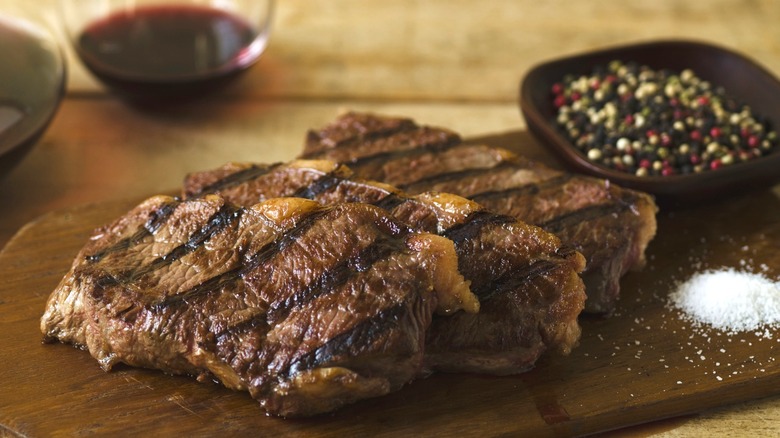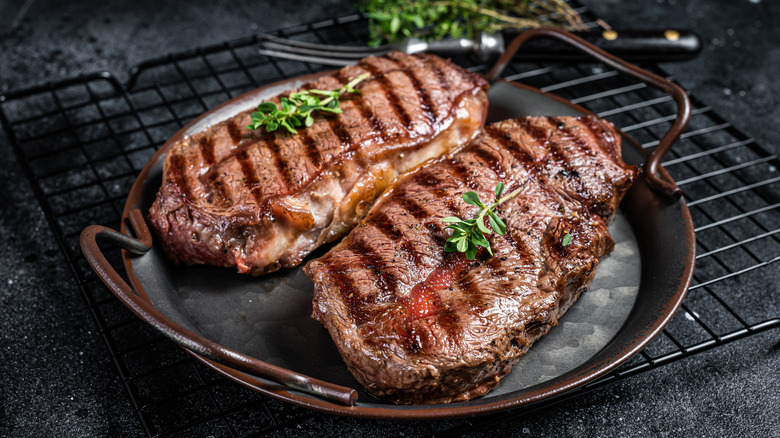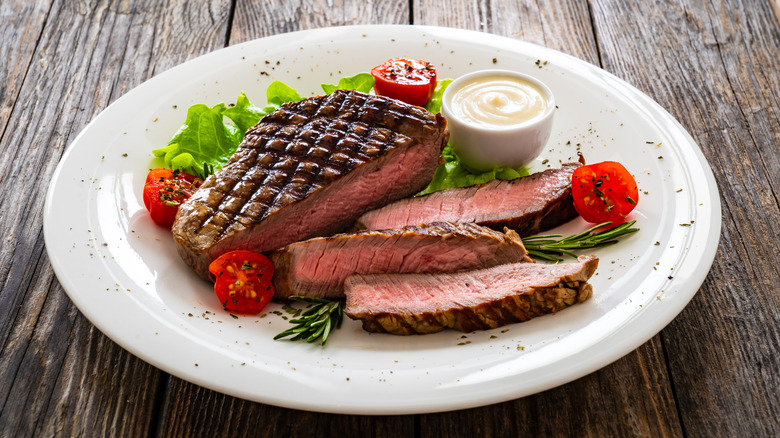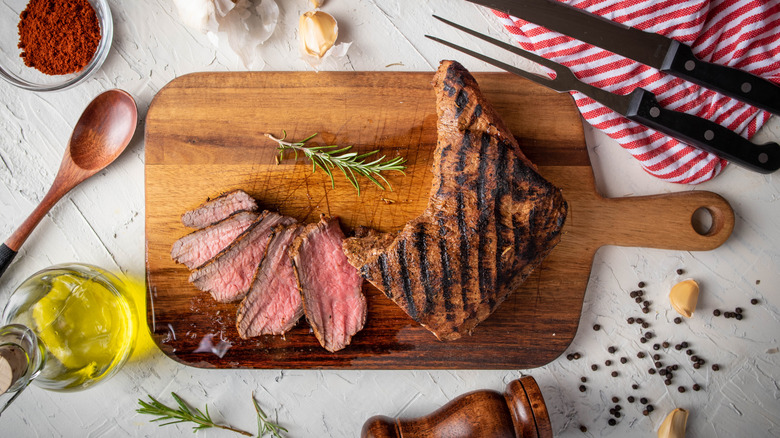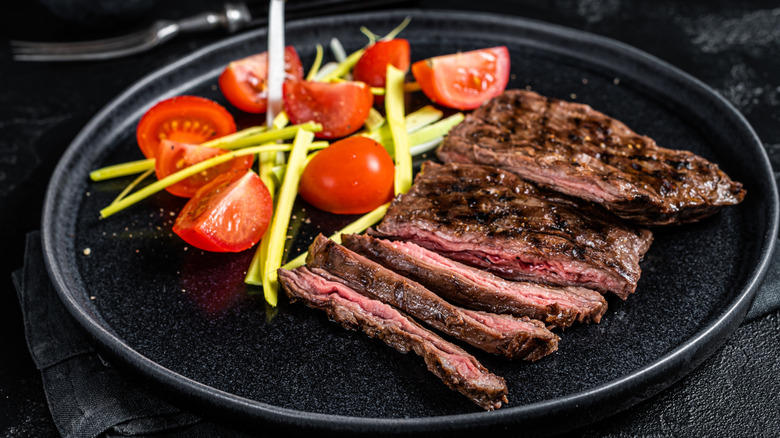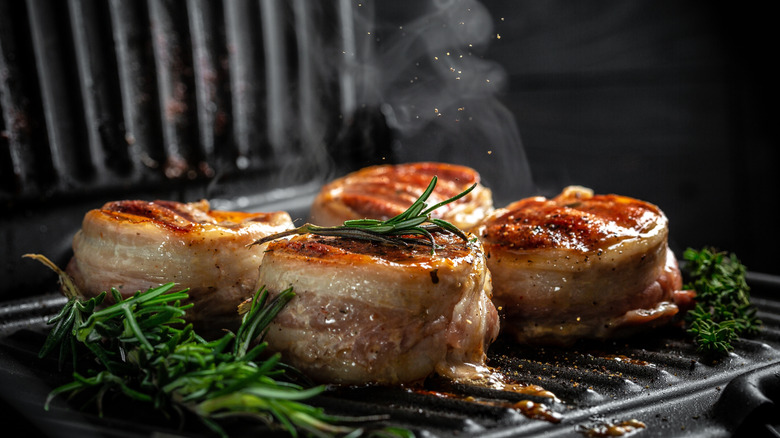The 4 Cuts Of Steak You Should Always Marinate Before Grilling
To marinate or not to marinate? This is the question, if beef is the subject. A good marinade, which may contain some form of acid, fat, and salt along with the possible addition of aromatics and sweeteners, serves several different functions including tenderizing the steak, adding flavor, and facilitating the browning process. That being said, it may not always be necessary to marinate your meat before grilling it. Which cuts of steak should be marinated? The Takeout spoke with restaurateur K.C. Gulbro, who co-owns the Geneva, Illinois steakhouse FoxFire and event venue Copper Fox, and is also a brand ambassador for Certified Angus Beef, and he told us, "The approach varies based on the cut and cuisine."
Gulbro says that larger, whole-muscle cuts of beef that will be slow-roasted or smoked on the grill do require a marinade — they might take up to 24 hours of soaking time. "This," he says, "allows the flavor to infuse into the meat and helps to tenderize and retain moisture." Smaller, thinner steaks that will be seared over direct grill heat, though, don't always need marinating, but in Gulbro's opinion, there are four cuts that can really benefit from this treatment: flat iron, sirloin, tri-tip, and skirt steak.
Flat iron
The flat iron may be one of the more symmetrical steaks. Its squarish cut is said to resemble an old-timey pre-electric iron, which is how it gets its name. This steak comes from the cow's shoulder, which is why you might also find it labeled as shoulder top blade, while it might also be called top blade steak or top blade filet. While it's one of the more economical cuts, it does have a fair amount of marbling that means it can cook up nice and tender. Still, K.C. Gulbro prefers to give this steak a bit of a boost by marinating it for anywhere from eight to 12 hours before grilling it.
As Gulbro explains, this extra-long soak "will break down some of the tough muscles, tendons, and veins" that you might find in a flat iron steak. It's also best to cook this fairly thick cut over a medium-high heat, since it may take a bit longer to finish than a thinner steak, but if you want a nice sear and you're using a gas grill with adjustable heat settings, you can start out on the highest one, then turn down the heat after the outside is nice and brown. Use a meat thermometer to check and see when it's done, bearing in mind that flat iron steak tends to be at its most flavorful at an internal temperature between 130 to 145 Fahrenheit.
Sirloin
If you've ever dined at a mid-range steakhouse and tried to pick out the cheapest steak on the menu, chances are it was a sirloin. Sirloin steaks manage to toe the line between being relatively affordable as far as steaks go, but still being sufficiently tender and tasty that Outback, Longhorn, and Texas Roadhouse aren't ashamed to feature them on the menu. Sirloin can benefit greatly from a marinade, though, since it's cut from the cow's hindquarters and can be on the lean side. In K.C. Gulbro's opinion, sirloin is another cut that could stand to be marinated for up to 12 hours to make it more flavorful and juicy.
As sirloin is such a versatile steak, just about any kind of marinade will work. You can go with a classic yet elegant mixture of red wine and herbs or opt for a sweet and salty mix like soy sauce and honey. Even a citrusy marinade can work with this meat — try a spicy southwestern-style one combining chiles, lime juice, and cilantro or a carne asada-style marinade made with orange juice.
Tri-tip
Tri-tip is usually a larger cut of meat weighing a pound and a half to two pounds. It consists of the pointy bit ("tip") at the end of the sirloin and is often associated with California's Santa Maria Valley since it's there that the cut was first used for barbecue rather than stew meat or ground beef. Tri-tip can be oven-roasted, but it's also possible to grill it. This won't be a quick process, though, since the meat, once it's been seared on each side, may need another 20 minutes over indirect heat.
K.C. Gulbro tells us, "I love Santa Maria-style tri-tip." His favorite way to prepare it, he says, is to dry-brine it for eight hours, then finish with a liquid marinade for another five hours before throwing it on the grill. Commercial Santa Maria spice rub made from garlic, parsley, pepper, and salt is available for purchase, or you could make your own by combining equal parts of each seasoning. You could also swap out the parsley for onion powder, oregano, or both, while other possible additions include smaller amounts of rosemary, sage, and cayenne to taste. As for the marinade, a 50/50 mix of red wine vinegar and oil will work just fine, although you could toss in a few crushed garlic cloves and stir in some mustard for extra flavor.
Skirt steak
Skirt steak, which comes from the middle of the cow (either the chest or abdomen), is tasty but tough, so it's a great candidate for a marination transformation. Depending on how it's cut, a skirt steak can weigh up to two pounds, but these steaks are seldom more than half an inch thick. For this reason, K.C. Gulbro advocates a shorter soaking time, anywhere from one to four hours. He also says, "Ingredients are key to the marinade time," and notes that, "Marinades with citrus, vinegar, and acid will work faster and could ruin your proteins if left on too long."
To be on the safe side, you might consider using less-acidic ingredients for your thin-sliced skirt steak. Yogurt makes for a milder marinade for your meat than citrus or vinegar since it contains lactic acid, a substance that can add moisture to meat without making it mushy. You can also skip the acid altogether and bathe your skirt steak in soy sauce and butter or go with a Korean barbecue-inspired soda marinade.
Some steaks don't require a marinade
There are a few steaks, however, that don't really need a marinade. As K.C. Gulbro says that, "Ribeyes and New York strips offer great flavor" — he sticks with a simple blend of salt, pepper, and garlic to season them. If you prefer a slightly more complex flavor blend, however, you can always add smoked paprika, oregano, cayenne, or sugar to the rub. This last ingredient, in particular, not only adds a hint of sweetness that accentuates the steak's meatiness, but it also melts into a perfectly caramelized crust.
Filet mignon is another steak that Gulbro feels may not need a marinade since it's tender enough on its own. That being said, there's some debate as to whether this cut should be grilled at all. Gulbro, it seems, is Team Grill, and he's not alone in this opinion, but others feel that this extra-lean steak is better when pan-seared. Gordon Ramsay is Team Pan all the way, while other chefs suggest using a reverse sear where filets are pre-cooked in the oven. If you do chose to grill this pricey cut, whether marinated or not, one way to make sure it doesn't dry out is to wrap it in bacon. This addition not only makes the steak taste bacon-y (never a bad thing), but the melting fat will drip onto the heat source and add some smoky flavor.
